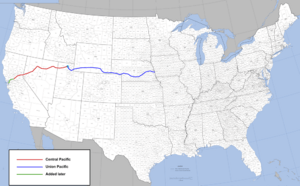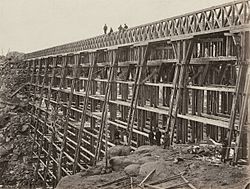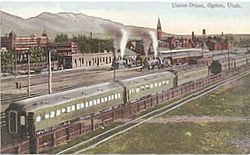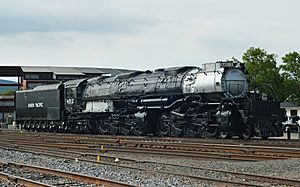History of the Union Pacific Railroad facts for kids
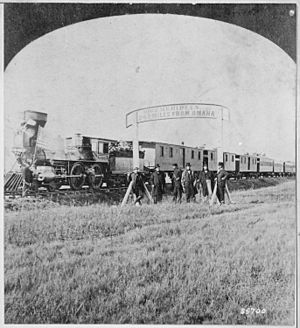
The Union Pacific Railroad has a long and exciting history, starting way back in 1862 and continuing to today! It's one of the most famous railroads in the United States. This article will tell you about the early days of the Union Pacific, from its beginning in 1862 up to 1998.
There have actually been four different companies called Union Pacific over the years. We'll focus on the first three: the Union Pacific Rail Road (1862–1880), the Union Pacific Railway (1880–1897), and the Union Pacific Railroad (1897–1998).
Contents
Building the First Transcontinental Railroad
The very first Union Pacific Rail Road (UPRR) was started and supported by the U.S. government. Laws were passed in 1862 and 1864 to help build it. The government wanted to connect California and Oregon more closely to the rest of the country, as it used to take six months to travel there! The UPRR was partly controlled by the government until the 1890s.
The main line of the UPRR began in Council Bluffs, Iowa. It stretched west to meet another railroad, the Central Pacific Railroad, which was building its tracks eastward from Sacramento, California.
Laying the Tracks Across America
Building the UPRR main line didn't really start until the American Civil War ended in 1865. In 1865 and 1866, workers built about 300 miles (480 km) of track across the flat prairies. The Rocky Mountains were a much bigger challenge! But the crews learned to work super fast. They built 240 miles (390 km) in 1867 and an amazing 555 miles (893 km) in 1868–69.
The two railroads, Union Pacific and Central Pacific, finally joined their tracks in Utah on May 10, 1869. This created the first transcontinental railroad in North America! This meant you could travel by train all the way across the country. Today, Interstate 80, a major highway, follows much of the original UPRR route.
In 1870, a train ticket from Omaha to San Francisco cost about $33.20. That's a lot for back then! The train would stop at special lunch spots along the way. Not many people took the long trip at first, only about 2,000 a month in the 1870s. But by the 1880s, it grew to 10,000 people a month.
Financial Ups and Downs
A famous businessman named Jay Gould took control of the UPRR in 1874. He also controlled a smaller railroad called the Kansas Pacific Railway. In 1880, he combined them into the Union Pacific Railway. This opened up new areas for the railroad in Kansas and Colorado, helping farmers and ranchers. The railroad also built lines to mining areas in Montana, Idaho, and Utah.
Even with these new areas, the Union Pacific had trouble paying back its old government loans. In 1893, a big financial crisis called the Panic of 1893 hit the country. Many companies, including the Union Pacific Railway, went bankrupt. This meant they couldn't pay their debts. Even though they were bankrupt, the trains kept running!
In 1897, a new company was formed, called the Union Pacific Railroad. This new company took over the old Union Pacific Railway. A very successful businessman named E. H. Harriman bought the Union Pacific for a low price. He made the railroad much better by upgrading its tracks and equipment. He also tried to combine it with the Southern Pacific Railroad, which was big in California. However, the Supreme Court stopped this merger in 1910 because it would create too much of a monopoly (meaning one company would control too much).
From 1910 to 1980, the Union Pacific didn't grow much. It mainly served farming, ranching, mining, and tourism in a large area from Omaha to Salt Lake City and Denver. It helped ship crops, cattle, and mining products to the East and brought consumer goods back. After 1980, the Union Pacific system grew a lot, adding more than 32,000 miles (51,000 km) of track by combining with other large railroads like the Southern Pacific and Missouri Pacific.
Money Matters and Challenges
The main Union Pacific line was finished in 1869. It cost a lot of money, about $109 million! About $50 million was for the actual building work. The rest included profits for the owners and money spent on things like selling bonds (a way to borrow money) and even some bribes to politicians.
The original UPRR got caught up in a big problem called the Crédit Mobilier scandal in 1872. This was about a construction company that had bribed members of Congress. The railroad itself wasn't found guilty, but it did get some bad publicity.
Another financial crisis, the Panic of 1873, caused more money problems for the railroad, but it didn't go bankrupt. Jay Gould took control in 1873 and made the railroad strong by focusing on shipping goods for local farmers and ranchers. He knew a lot about how the railroad worked and how to manage its money. He helped the Union Pacific Railway become a successful company.

After Jay Gould passed away, the Union Pacific Railway struggled and went bankrupt during the Panic of 1893. But by November 1897, the country's economy was getting better, and the railroad started making money again. An agreement was made to pay back all the money the government had loaned, plus interest. The government got every dollar it was owed from the Union Pacific.
In 1897, the new Union Pacific Railroad was formed. This company took over the old Union Pacific Railway. E. H. Harriman bought the railroad cheaply and made it much more efficient and profitable. He tried to create a huge railroad system in the West, but the Supreme Court stopped him because it would have been a monopoly.
How the Railroad Was Built
Thomas C. Durant was in charge of building the UPRR. He chose routes that were cheap to build, which would make more profit from the government loans. He didn't always pick the best routes for future economic growth.
Building the railroad happened in steps:
- First, surveyors (often protected by the Army) mapped out the exact path. They tried to make it as flat as possible to avoid needing too many bridges.
- Next, grading crews used plows and shovels to prepare the ground.
- Finally, workers laid down the wooden ties and then the metal rails. They also set up telegraph lines, signals, and switches.
In the summer of 1865, Omaha became the main supply base. Thousands of tons of rails, ties, tools, and other supplies were brought there. As soon as a few miles of track were ready, supplies were moved forward by horse or mule wagons. Eventually, crews could lay several miles of track each day! The record was 10 miles (16 km) in one day. Most of the hard work was done by Irish immigrants using picks, shovels, and wheelbarrows.
The original UPRR track was 1,087 miles (1,749 km) long and started in Council Bluffs, Iowa. Winter and spring were tough because the Missouri River would freeze, but not always strong enough for a train. So, train ferries had to be replaced by sleighs each winter. Starting in 1873, trains could cross the river on the new 2,750-foot (840 m) long Union Pacific Missouri River Bridge to Omaha, Nebraska.
The railroad crossed the Elkhorn River and the 1,500-foot (460 m) Loup River bridge. It then followed the north side of the Platte River valley west through Nebraska, generally following the paths of the Oregon Trail, Mormon Trail, and California Trail.
During the winter of 1865–66, former Union General John S. Casement, the new Chief Engineer, gathered workers and supplies to push the railroad quickly west. To protect the surveying and hunting teams, the U.S. Army sent cavalry patrols, which grew larger as Native American groups became more active. Temporary towns, often made of canvas tents, moved along with the railroad as it was built. These were called "Hell on Wheels" towns. Most of them disappeared, but some became permanent settlements.
The railroad built a 2,600-foot (790 m) long bridge over the North Platte River at North Platte, Nebraska, in December 1866. By then, they had completed about 240 miles (390 km) of track that year. In late 1866, General Grenville M. Dodge became the Chief Engineer for the Union Pacific.
A new route was found in 1867 that went along the South Platte River in western Nebraska and into what is now Wyoming. It climbed a gentle slope to Evans Pass (8,200 ft or 2,500 m), which was discovered in 1864. This "new" route was about 150 miles (240 km) shorter, flatter, and cheaper to build. It also passed closer to Denver and known coalfields. The railroad gained about 3,200 feet (980 m) in elevation over 220 miles (350 km) from North Platte to Cheyenne, which is a very gentle slope. This route hadn't been used by wagon trains because it lacked water and grass for their animals. But steam locomotives didn't need grass, and the railroad drilled wells for water. Coal was also found in Wyoming, which was a great source of fuel for the trains.
The Union Pacific reached the new railroad town of Cheyenne in December 1867, having laid about 270 miles (430 km) that year. They paused for the winter to prepare to build over Evans (Sherman's) Pass. At 8,247 feet (2,514 m), Evans/Sherman's Pass is the highest point on the transcontinental railroad. The Dale Creek Crossing bridge was one of the most difficult engineering challenges. Cheyenne became a very important railroad center with large yards and repair shops. Its location made it a good base for extra locomotives to help push trains over Evans Pass or clear snow from the tracks.
The railroad also created new towns along its path, such as Fremont, Grand Island, North Platte, and Laramie. The Green River was bridged on October 1, 1868, which was the last major river to cross. Evanston became an important town for train maintenance and repairs.
In Utah Territory, the railroad went through the rugged Wasatch Mountains and down Echo Canyon and Weber River canyon. To build faster, Union Pacific hired thousands of Mormon workers to cut, fill, bridge, blast, and tunnel their way down the Weber River Canyon to Ogden, Utah. The longest of four tunnels in Weber Canyon was 757 feet (231 m) long. These tunnels were built using a new explosive called nitroglycerine, which sped up the work but also caused some accidents.
The tracks reached Ogden on March 27, 1869. Then, they went north of the Great Salt Lake to Brigham City, Utah and Corinne, Utah, before finally connecting with the Central Pacific Railroad at Promontory Summit in Utah on May 10, 1869.
Expanding the Network
In the 1860s, the original Union Pacific bought three smaller railroads built by Mormons in Utah and Idaho. It also built or bought local lines to reach important places like Denver, Colorado, Portland, Oregon, and the Pacific Northwest. It acquired the Kansas Pacific Railway, which gave it more reach. The Union Pacific also owned lines that went into the mining areas of the Colorado Rockies and a line south from Denver into New Mexico and Texas.
Business Practices
The transcontinental railroad was a huge technological achievement in the 1800s. However, there were some problems with how the money was handled, leading to government investigations. The way companies kept their financial records was still developing back then.
Congress didn't fully trust the Union Pacific, so they made them hire a new president, Charles Francis Adams, Jr., in 1884. Adams tried to improve the railroad's image and even set up libraries for employees. However, he had trouble dealing with labor unions. For example, when workers refused extra work in Wyoming in 1885, Adams hired Chinese workers. This led to a terrible event called the Rock Springs massacre, where many Chinese workers were killed or driven out of Wyoming. Adams also struggled to make decisions and manage his team. He couldn't fix the railroad's financial problems, and in 1890, Jay Gould forced him to resign.
Selling Land to Settlers
Besides making money from shipping goods and passengers, the Union Pacific also earned money by selling land. The government gave the UP 12,800 acres of land for every mile of track built. The government kept every other section of land, which it also sold or gave to settlers.
The railroad's main goal in selling land wasn't just profit. They wanted to create a steady group of farmers and townspeople who would use their trains regularly. The UP opened sales offices in the East and in Europe. They advertised a lot and offered good deals for farmers to move their families and tools to new areas. In 1870, the UP offered rich Nebraska farmland for five dollars an acre. Farmers could also get land for free from the government through homesteading after five years, or buy it sooner for $1.50 an acre. Sales improved when they offered large areas to groups of European immigrants. Many Germans and Scandinavians, for example, sold their small farms back home and bought much larger farms in America for the same money. By the late 1800s, about half of Nebraska's population was made up of European immigrants.
Union Pacific in the 20th Century
Harriman's Influence
E. H. Harriman became the head of the Union Pacific in 1898. Until his death in 1909, he made all the important decisions for the railroad. In 1900, he combined the UP with the larger Southern Pacific Railroad to make it more efficient and powerful in the Southwest. However, the Justice Department sued, and in 1912, the Supreme Court ordered the two companies to separate. The court said that combining them would stop competition and was against the law.
World War II Efforts
The Union Pacific was very patriotic during World War II. They helped a lot with the war effort. For example, a Boeing B-17 Flying Fortress airplane was named Spirit of the Union Pacific. This was to honor the money that Union Pacific employees donated to buy war bonds. Sadly, the plane was shot down over Germany in 1943, and most of its crew became prisoners of war.
Passenger Trains and Historic Locomotives
Between 1869 and 1971, Union Pacific ran many passenger trains on its famous "Overland Route." The last passenger train operated by UP arrived in Los Angeles on May 2, 1971. Since then, Union Pacific has allowed Amtrak trains to use its tracks for passenger service.
Famous Passenger Trains
Here are some of the well-known passenger trains that used to run on Union Pacific lines:
- Challenger
- City of Denver
- City of Los Angeles
- City of Portland
- City of San Francisco
- City of St. Louis
- Los Angeles Limited
- Overland Flyer (later Overland Limited)
- Portland Rose
Historic Locomotives Still Running or Preserved
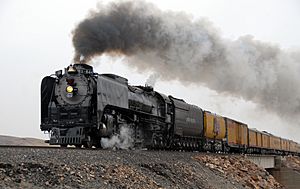
The Union Pacific Railroad is special because it still keeps a small group of historic locomotives in working order at its roundhouse in Cheyenne, Wyoming. These are used for special trips and events.
- UP 844 is a powerful steam locomotive. It was the last steam engine built for UP in 1944 and has been running ever since! It's the only steam locomotive that has never officially retired from a major North American railroad.
- UP 4014 is a huge steam locomotive called a Big Boy. It's the largest working steam locomotive in the world! It was built in 1941 and ran until 1961. After being on display for many years, Union Pacific brought it back in 2013 and spent years restoring it. It returned to service in May 2019 and is a truly amazing sight to see.
There was another famous steam engine, UP 3985, a Challenger type. It ran special trips from 1981 until 2010. In 2022, it was donated to a group that plans to restore it to working order again.
Union Pacific also keeps some historic diesel locomotives, like the UP 951, 949, and 963B. These sleek passenger locomotives were built in 1955. While they look old on the outside, their engines and controls have been updated.
Many other Union Pacific locomotives have been saved and are on display in towns and museums across the country.
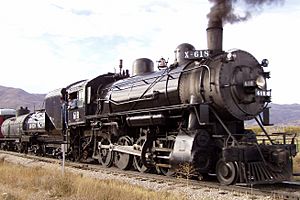
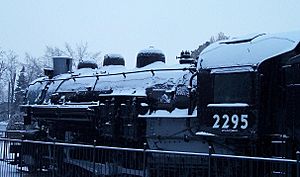
Historical Presidents
Here are some of the people who led the Union Pacific Railroad over the years:
- William Butler Ogden (1862–1863)
- John Adams Dix (1863–1865)
- Oliver Ames, Jr. (1866–1871)
- Thomas Alexander Scott (1871–1872)
- Horace F. Clark (1872–1873)
- John Duff (1873–1874)
- Sidney Dillon (1874–1884)
- Charles F. Adams (1884–1890)
- Sidney Dillon (1890–1892)
- S.H.H. Clark (1890–1898)
- W.S. Pierce (acting) (1897)
- Horace G. Burt (1898–1904)
- E. H. Harriman (1904–1909)
- Robert S. Lovett (1910–1911)
- A.L. Mohler (1911–1916)
- E.E. Calvin (1916–1918)
- C.B. Seger (1918–1919)
- Carl R. Gray (1920–1937)
- William M. Jeffers (1937–1946)
- G.F. Ashby (1946–1949)
- Arthur E. Stoddard (1949–1965)
- E.H. Bailey (1965–1971)
- John Kenefick (1971–1986)
- William S. Cook (1977–1987)
- Drew Lewis (1986–1987)
- Mike Walsh (1987–1991)
- Richard K. Davidson (1991–1996)
- Ron Burns (several months in 1996)
- Jerry Davis (1996–1998)
- Ike Evans (1998–2004)
- James R. Young (2004–2012)
- Jack Koraleski (2012–2015)
- Lance Fritz (2015–current)
Images for kids



